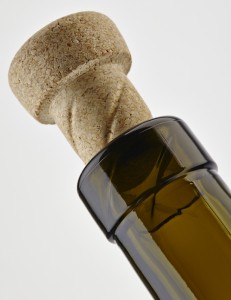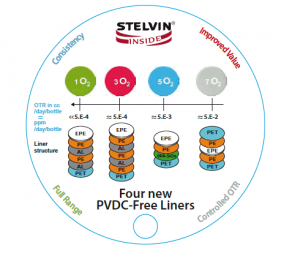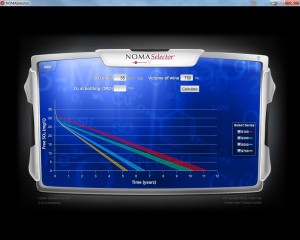Closures – research and innovation
A version of this article was first published in the August 2014 issue of Drinks Business magazine.
There’s a lot going on in the closure world, though it may be some time before we get to hear about some of it.
TCA et al. seems to be hanging around in the corner, or even, dare one suggest, drifting off in a state of ennui. OTR is the bigger fish these days. And sustainability issues provide more innovative excitement than anything to do with TCA.
External, third party validation of OTR rates has become the norm, for most; just part of the product spec these days. Offering a range of options in the OTR department is also becoming the norm. Nomacorc has supplementary whizz-bangy kit that allows winemakers to input broad winemaking details. An algorithm churns out the best fit of their closures from their range of four OTR options on their Select series. Amcor also now offers four OTR options for their Stelvin screwcap, but presents them as options. It’s up to the winemaker to know his/her wine and choose the most appropriate liner.
With such step-change innovation, it takes time for producers to evaluate. Amorim’s Helix, launched at Vinexpo 2013, is in trial at more than 50 wineries in Europe. This is a cork that needs no corkscrew and is targeted at the capacious £5 to £10 sector. It does need a special bottle with an internal thread in the neck bore. But a cork that competes with the utter convenience of screwcap, both opening and resealing, is real innovation.
Screwcaps often get bundled together, but all things are far from equal in this market sector. As well as aluminium quality for the stopper construction, we know the seal is provided by the liner. SaranTin and Saranex liners have long been the only choice. But in 2013, Amcor, the manufacturers of Stelvin, launched four new liners with different OTRs.
The OTRs of Stelvin Inside have been measured by France’s LNE (Laboratoire national de métrologie et d’essais” at a SaranTin equivalent <0.0005 ccO2/day for their 1O2, up to 0.05 ccO2/day for their 7O2. 5O2 is equivalent of Saranex at 0.005 ccO2/day with 3O2 offering at OTR between that of SaranTin and Saranex (~0.0005 ccO2/day). Didier Ruffy, Stelvin’s R&D manager said 7O2 was developed “in response to a request from the USA market to test a liner with higher permeability than Saranex in order to age the wine.” Their communications manager Karen Quirchove added “some synthetic closures are in the 7O2 area. There are no other aluminium closures in this arena. It is a new range for us to cover.” It becomes even more important to ask about the liners.
These are also undergoing commercial trials in wineries across the world, having been launched to the trade at the beginning of 2013. Quirchove said “several million have been sold in USA, Europe and Australia. Producers are testing them.” Ruffy added “for whites, we could get some answers in eighteen months. For reds it will be longer.” Typically he said, wineries are testing all four liners, which are available only inside the original Stelvin closure, i.e. not StelvinLux or StelvinP for semi-sparkling wines.
OTRs are all about consistency. The challenge of single piece natural cork is consistency, because it’s natural. Composite corks (bits of ground up cork glued together – technical agglomerate corks) are typically consistent. Membrane barriers, added to the ends of corks, aim to add consistency to cork, at the same time offering up a specific OTR performance.
A couple of membrane producers have been around for a while. They add a barrier membrane to the ends of single-piece natural cork or composite corks, which typically have previously undergone some sort of TCA cleansing process such as steam distillation.
The membrane provides a consistent OTR, overcoming the key inconsistency criticism of single-piece cork. In the last decade the Procork stopper has evolved, notably with a coating being applied around the sides of the cork. Gregor Christie, Procork’s CEO, said the “side coating reduces the amount of vapour that moves up and down the side, providing some degree of barrier. In combination [with the end membranes] it works well, and we don’t get taint issues.” A criticism of the membrane barrier only being on the end of the cork is that TCA on the uncoated side might contaminate the end membrane of other stoppers in a bag. TCA would adsorb to the membrane and desorb into the bottled wine. But “TCA is not something that happened a lot. Wineries are more driven by oxidation and consistency” which the membrane addresses, Christie added.
Procork comes in a range of OTRs. Their recommendation for fast rotation wine, Christie said “is a very low permeability approaching a tin foil screwcap. This is counter to what some plastic cork manufacturers suggest where they promote the extra permeability allowing the wine to smooth off quicker for quick consumption. We suggest the opposite because that work can be done in the winery where it can be more controlled and the wine prepared for bottling in a forward state exactly as the winemaker wants. The low permeability cork can hold that state for longer than a high permeability cork, so the low permeability can give a longer shelf life.”
The Corkguard (formerly known as Bacchus) barrier membrane was re-launched earlier this year. This technology is newly available as Smartcork corks. The Smartcork company adds Corkguard to single piece corks, “transforming low grade corks to high grade corks” said David Taylor, the managing director of Corkguard Technologies. The OTR is stated at 0.002 cc02/day, equating to 1 to 3 years’ shelf life. Taylor added that membranes with different OTRs are likely to be available within a year. As with other new launches, commercial winery trials are the next step.
In addition to consistent OTR, both these barrier technologies offer a partial barrier to TCA. Taylor said Smartcorks “are selected and cleaned so that they have less than 1ppt to begin with. To this we add the membrane which slows the transfer of these low levels of TCA into the wine so that it is highly unlikely that any TCA damage will occur.”
The vanguard of closure innovation also includes improving sustainability quotients. This, notwithstanding the closure is typically just 1-2% of the total (glass)-package weight.
In 2013, Guala Closures carbon dioxide offset 1 billion screwcaps (about two-thirds of their wine stoppers), planting 80,000 trees in north east India in the process. Prior to this, in 2012, they, and other screwcap manufacturers including Amcor, clubbed together to promote screwcaps and their recyclability. Together these manufacturers represent 80% of global wine-screwcap production. Given that recycling aluminium needs up to 95% less energy than during its initial production, raising recycling rates from the 40% level across Europe is important. Anne Seznec, their marketing manager, said communication had to be targeted because “according to country, the cap may be left on to recycle with glass or collected separately with other aluminium.”
Nomacorc’s innovation frontier is SelectBio, a (partially) synthetic stopper of which 60-80% is made from non-GMO, Brazilian sugar cane. It was launched in Europe in late 2013 and the USA in mid-2014. SelectBio comes in the same OTR options as (fully) synthetic Select series, except there is no SelectBio 700. Katie Myers, Nomacorc’s communication manager said “SelectBio is our focus for the next twelve months. It is of interest to retailers who have already done the low hanging fruit of sustainability – the package, and transport.” SelectBio, she added “has a negative carbon footprint.”
Myers reassured the Amazon was not in danger from sugar cane production for their stoppers, saying “one million SelectBios come from just one hectare”!
Other innovation – VINOLOK
For pure elegance of appearance and style, little beats Vinolok. Since the company’s purchase by specialist cut crystal producing company Preciosa in 2011, who have manufactured the stoppers since their introduction to the market in 2004, re-invention has been the driving force. Kateřina Slezáková, their marketing specialist, said an early innovation was to “widen the range to standard bottles” because a limiting factor for the original incarnation had been the necessity for a special bottle neck with an external ‘bobble’. A range of more than 30 bottles exists for both wine and spirits from a selection of preferred bottle manufacturers with whom they’ve worked “to control the quality, mainly of the inner shape of the bottle neck”. Vinolok now fits different neck bore diameters.
Testing by AWRI of the new kit, including liners made of a different material, found OTR rates “consistent with levels typically seen for some agglomerate (technical cork) and synthetic closures”.
Vinolok now comes in a bountiful number of colours for added marketing appeal.
Other innovation – DIAM
Diam is going down the longevity path. It has long since gone past TCA issues with its supercritical carbon dioxide cleaning process. It has also offered different OTRs for a while. The latest incarnation is the Diam30 which has been developed for long bottle ageing of grand cru style wines. Dominque Tourneix, the director general of Diam Bouchage said “The most recent release [beginning of 2014], has been Diam30, with a mechanical guarantee of 30 years. This has been developed using an accelerated ageing process methodology that is inspired from the aviation industry by exerting a mechanical compression under high temperature. We have been able to design the required elasticity of the cork structure to achieve 30 years sealing guarantee.” Where wine is stored below 15°C, no leakage is guaranteed. Additionally it has a very low OTR, stated at 0.0004 ccO2/day.
Tourneix added “Nearly 1 million Diam30 have been sold, representing 50 clients from Italy, France, Australia, Switzerland, Germany, Spain and USA. Orders from each client are small as they are destined for their premium brands.” This will stretch the boundaries of real-time trials – don’t expect any news any time soon. END OF BOX OUT
Other innovation – GUALA CLOSURES
The pressure in fully sparkling wine bottles has ceased to be a barrier for screwcap maker Guala Closures (which company also reports working on different liner construction). They recently released a closure for fully sparkling wine, with a capability up to 10 bar, giving it a margin of error well above the 6 bar typically found in Champagne and other bubblies of that ilk. Initially this has been taken up in Australia, where it was developed, and Germany.






